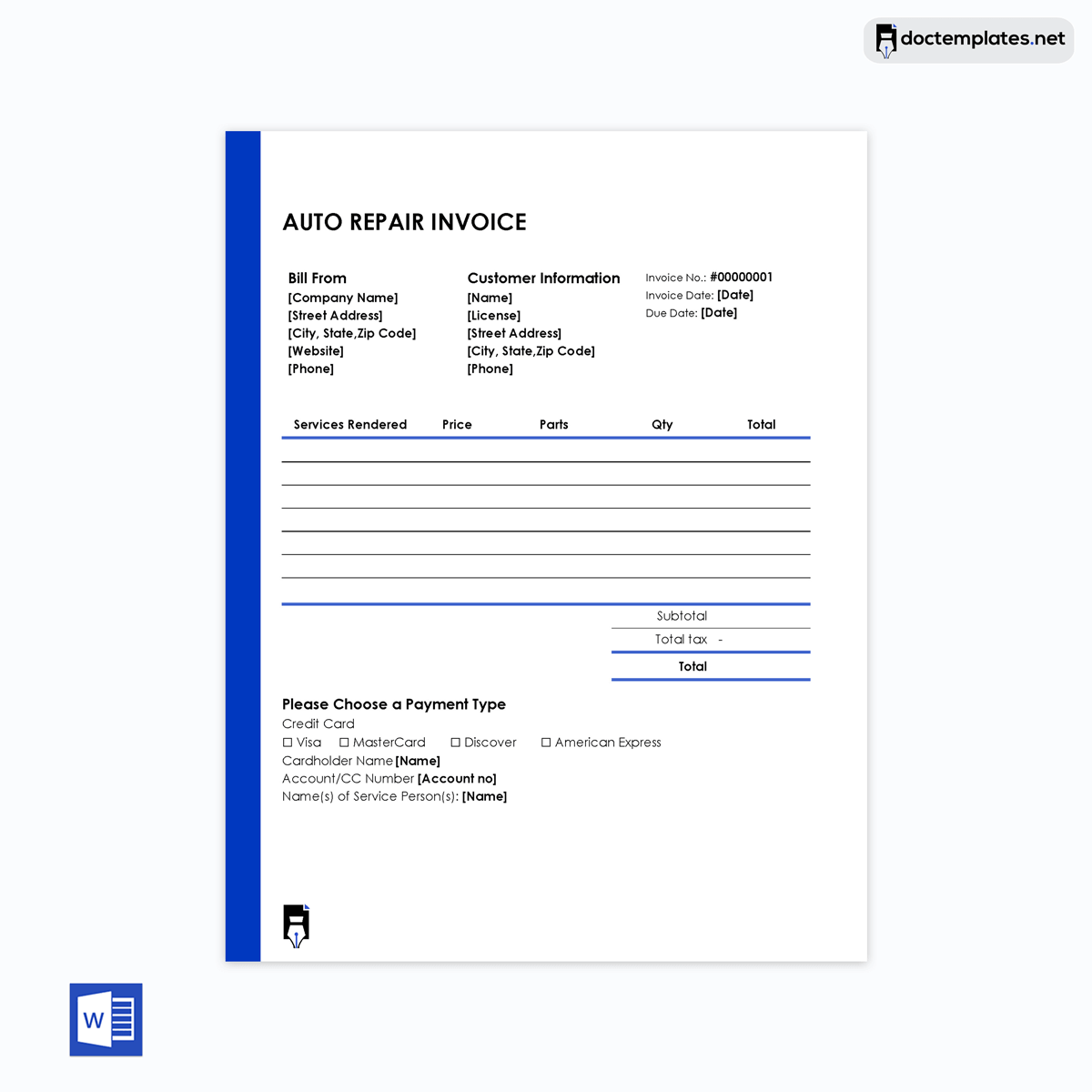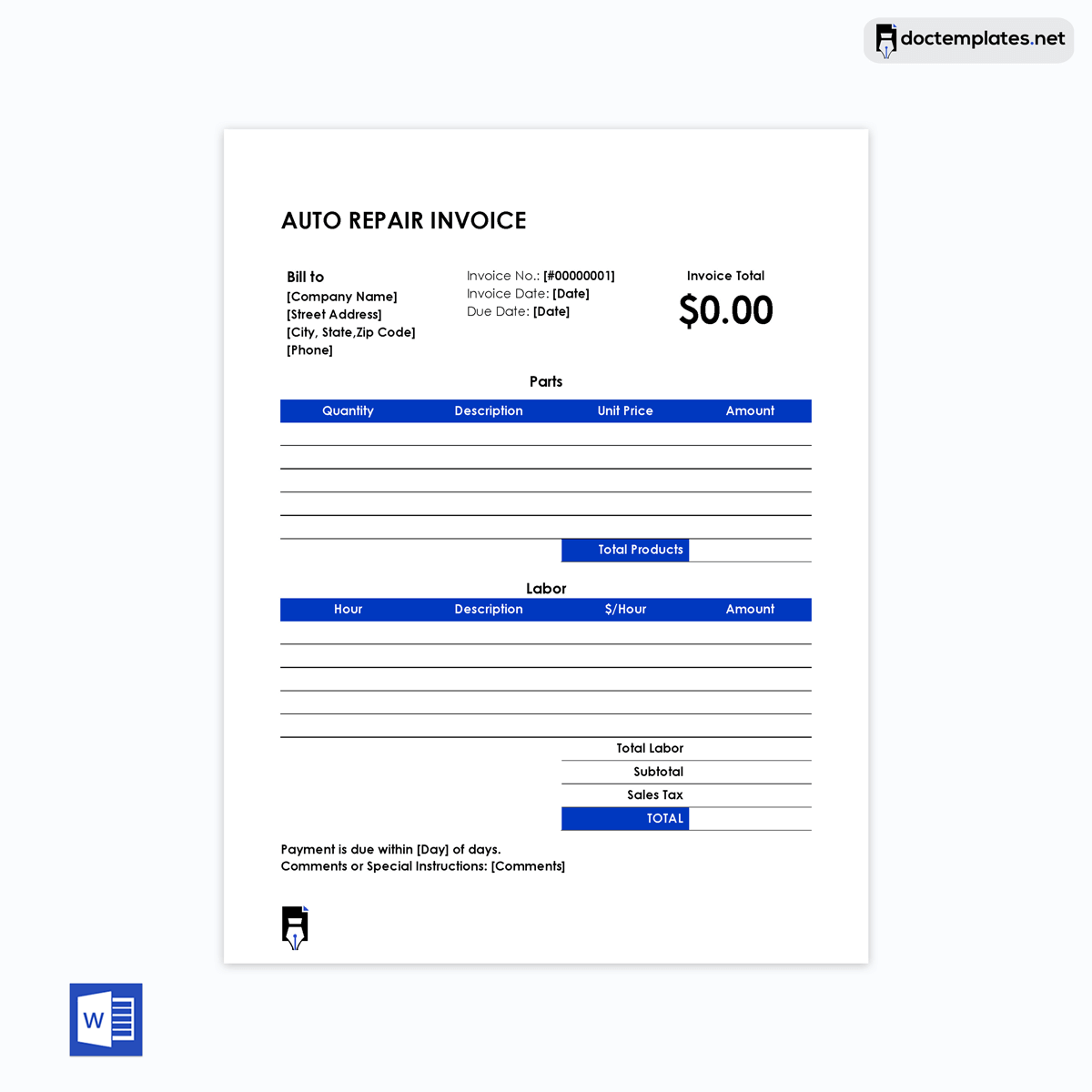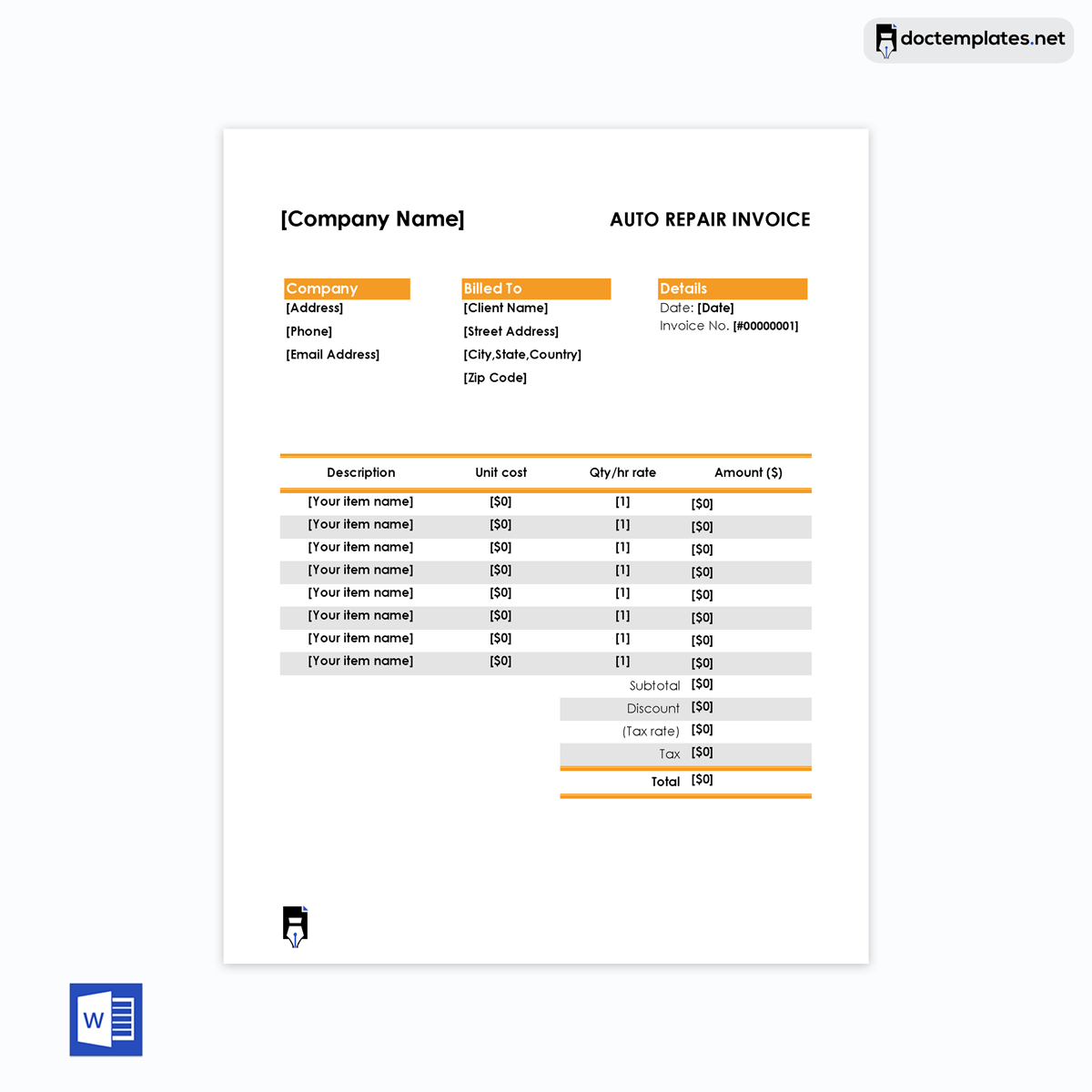Invoicing can be challenging in the auto repair industry for multiple reasons. The most common challenge is the complexity of the invoicing process. It can be difficult to keep track of all charges and generate an invoice that accurately reflects all the costs associated with a repair. Without an effective invoicing strategy, you may encounter problems when filing your taxes or during an audit.
This article aims to inform shop owners about the essentials of an auto repair invoice and how to draft invoices for their customers.
Auto Repair Invoice Templates
Given below are auto repair invoice templates:
What is an Auto Repair Invoice?
An auto repair invoice is a document that auto repair shops use to bill customers for the services and parts provided.
It typically includes information about the services performed, the parts used, and the cost of each item. It may also include any applicable taxes and any discounts or promotions that have been applied.
The invoice needs to be clear and easy to understand so that the customer knows what they are being charged for and can make an informed decision about how to pay. In most auto repair shops, the vehicle owner is required to pay for the services upon receipt, while other shops can give thirty or sixty days. This is referred to as “Net 30” or “Net 60,” respectively, on the invoice. An auto repair invoice can be utilized for any type of vehicle, from a sedan to a truck. Both part-time and full-time technicians can make use of an auto repair invoice to bill their customers.
Do you know? Automotive service is one of the best-paying blue-collar professions. In the United States, there are 629,780 registered auto-service technicians and mechanics. They account for 0.7% of the employed population. On average, mechanics and auto-service technicians earn a mean wage of $23.07 per hour, which translates to a mean annual wage of $47,990.
What is an Auto Repair Invoice Used for?
As an auto shop owner, you strive to have your clients’ vehicles ready when they wish to collect them. The invoice records the work performed on a vehicle, including the specific tasks the technician completed and the parts they changed. The technician can also use the invoice to track payments from the customer, including the amount paid and any remaining balance. This record is helpful for the customer and the shop owner, as it clarifies what was done and why it was necessary.
Issuing your clients with auto repair invoices is not only the best practice, but it also allows you to track your shop’s finances and gauge revenue generation. In addition, the invoice is used for billing the customer for the work done. It typically includes the total cost of the repair, as well as any applicable taxes or fees. This allows you to make follow-ups on due accounts, track your clients, and collect payments. If the invoice has a specific due date, the invoice may serve as proof of uncleared payments.
The services charged on an auto repair invoice may include general repair, oil changes, brake fittings, and repairs, suspension overhaul, tire replacement, body repair, panel beating and spray painting, exhaust repair, fuel system repair, tune-ups, transmission repair, AC maintenance, window repair, or glass repair.
In some cases, the repair work may be covered by an insurance policy. Therefore, the auto repair invoice can be used as documentation for the insurance company to help process the claim. Finally, the repair shop can use an auto repair invoice to track its financial records and ensure that it is properly compensated for its services. Most auto repair shops use billing software to generate invoices because they are more accurate. They also save time and maintain the professional stature of the shop.
If you work on many vehicles in your shop, a template can save you time during the invoicing process so you can get paid promptly. The template has pre-filled placeholders that you can edit with the details of the repair. Most auto repair invoice templates have formulas that calculate the totals, keeping you organized.
How to Create an Auto Repair Invoice
After repairing your client’s vehicle, you will have to bill them for services rendered with an invoice. Here are the steps you can follow to create an auto-repair invoice:
Name your invoice
On the top of your page, include the name of your company in the format shown below:
[Company Name] | Auto Repair Invoice
Add your company information
Below the name, enter your company information. Begin by placing your company logo, including the telephone, physical, email, and fax numbers. In case of a dispute or inquiry, your client can reach you through these channels.
Enter your company information in the format shown below:
[Street Address]
[Phone Number]
[Email Address]
[Fax Number]
Include a date
Below the company details, enter the date the invoice is being generated. In some cases, you may include the date your client brought the vehicle for repairs. The date is a reference for you, especially if the client will pay the invoice later.
Include the client’s details
Enter the client’s details, including the contact information. You may reach your client through these channels to follow up on the vehicle’s condition or resolve a payment issue.
Enter the information in the format shown below:
Customer Information:
Name:
[Customer Name]
Address:
[Customer Street Address]
Phone:
[Customer Phone]
Email:
[Customer Email]
Date:
[Invoice Issuance Date]
Add vehicle details
Enter the details of your client’s vehicle. In the case of an insurance claim, the insurance company might need these details for their vehicle. The vehicle’s details also help you identify vehicles in your shop if you are repairing more than one vehicle of the same make and model.
Enter the vehicle details in the format shown below:
Vehicle Information:
Registration:
[Vehicle Registration Number]
Make:
[Vehicle Make]
Model:
[Vehicle Model]
VIN:
[Vehicle VIN]
Year:
[Vehicle Year of Manufacture]
Include details of the parts
This information should be tabulated. Begin by entering the quantity, followed by the part number and name, then enter the unit price of a single part. Next, calculate the total cost of each part type (Quantity * Unit Price) and enter the cost of the part in the cost column. Finally, sum the cost of each part and enter the total at the bottom of the table.
Calculate the total labor cost
The labor cost information should also be tabulated. Start by entering the hours spent on each task, followed by a brief description of the repair work. Next, enter the cost per hour of each task, then calculate the total cost of each task (Hours * Cost Per Hour). Finally, sum up the cost of each task and enter the total at the bottom of the table.
Calculate the total cost
Sum up the total parts and labor amounts (Parts Total + Labor Total). In some cases, you may add the costs of other miscellaneous consumables that are not part of the parts or labor, such as a car wash or a five-point check.
Finally, include taxes and any discounts, then enter the total cost in the format shown below:
Total Cost:
$[Total cost of repair]
Discount:
$[Discount]
Taxes:
$[Total taxes and fees]
Total Due:
$[Total due, including cost, discounts, and taxes]
Specify warranty terms
Enter the warranty terms for each part you installed. The terms should indicate the condition to replace each part should they be damaged. The terms should also specify the time frame that the replacement can be done at no cost to the client.
Include payment terms
Enter the payment terms for the invoice. Specify whether the invoice is due on the vehicle’s delivery day, 30 or 60 days. Include all the payment methods your company accepts, for example, cash, check, card, or bank transfer. Finally, enter the date that the invoice is due.
Save and send the invoice
Finally, save the document on your computer as a PDF file. You can attach the PDF file to an email and send it to your client. Alternatively, print the invoice and mail a hard copy to the client.
Important Considerations
A well-designed auto repair invoice ensures you receive your payment promptly. Therefore, you should take the time to verify that all the information on your invoice is presented correctly.
The following are some of the considerations you should make during the invoicing process:
Issue the invoice immediately
Timely billing helps to maintain good relations with your customers. Issuing the invoice on time shows that you value your customers’ time and business and helps to build trust and maintain good relations. Prompt billing helps to avoid misunderstandings or disputes about the work you performed or the cost of the repairs.
Sometimes, tax laws or regulations may require you to do so. For example, in some jurisdictions, you may be required to issue invoices within a specific timeframe to claim certain tax deductions or credits.
Include a number for each invoice
Assigning a unique number to each auto repair invoice makes tracking and managing invoices easier for you and your clients. It also helps to prevent errors, such as lost or misfiled invoices. Most importantly, having a numbering system for auto repair invoices can facilitate prompt payment, allowing your clients to reference the invoice when making a payment quickly. Finally, a numbering system for auto repair invoices can help ensure that your business maintains accurate records of all invoices issued, which can help reconcile accounts.
Use an invoice template
Consider using an auto-repair invoice template, as it helps you save time. It is a pre-made document that you can easily customize with your company information, client information, and the specific details of the repair work performed. You also improve your company’s look and make a good impression on your clients. Using a template ensures that all of your invoices are consistent in terms of layout, formatting, and the information included. This consistency can make it easier for your clients to understand the invoice.
Use invoicing software
You can utilize invoicing software such as Scoro, QuickBooks, or FreshBooks to help you streamline billing and payment processes. Invoicing software allows you to create and send invoices, track payment status quickly, and follow up on unpaid invoices.
In addition to saving time, invoicing software can also improve the accuracy of your invoices by automatically calculating totals and ensuring that all necessary information is included. Finally, invoicing software can help you better organize your invoicing process by allowing you to store invoices electronically and easily retrieve them when needed.
Conclusion
Auto repair invoices are essential as they provide a detailed record of the work you performed on a vehicle and the cost of the repairs. When creating an auto repair invoice, it is important to include all necessary information, such as the client’s information and a description of the repair work performed. Specifying the payment terms and including applicable discounts or promotions is also essential. Using an invoice template or invoicing software can save time and improve the accuracy and professionalism of your invoices.
Finally, issuing invoices promptly and keeping accurate records of all invoices sent is crucial. It would be best if you could create professional-looking auto repair invoices to help you maintain good relations with your clients, streamline billing and payment processes, and guarantee your company’s financial health.





